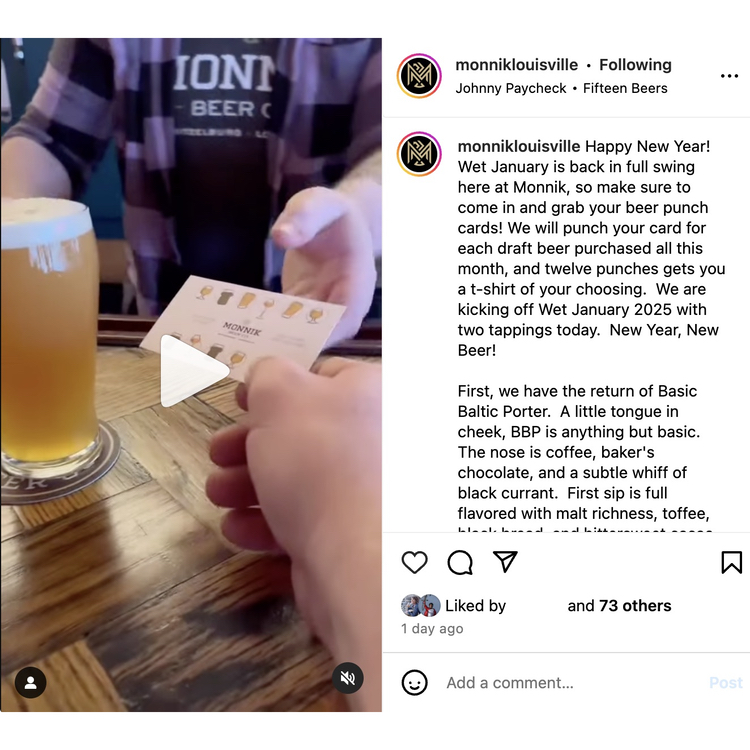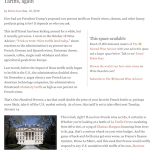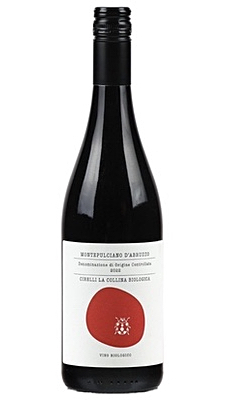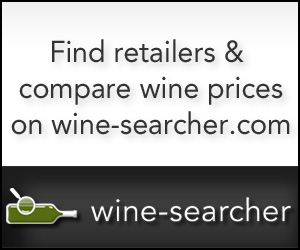Are you observing Dry January? Whether you’re swearing off alcohol for January or staying “wet,” you probably have opinions about this current fad.
What’s a Dry January, anyway? >New York Times writer Melinda Wenner Moyer explained it for us in an article last year, “What Happens to My Body During Dry January?”
“Champagne, eggnog, mulled wine– for many, the holiday season is a time for celebration, which typically involves copious amounts of alcohol,” she wrote. “So it’s no surprise that an estimated 15 to 19 percent of U.S. adults in recent years have pledged to participate in Dry January, or ‘Drynuary,’ in an effort to atone for their December choices and, hopefully, slightly unpickle their livers.”
Dry January?
Are you swearing off or reducing wine consumption this month? What’s your take on “Dry January”?
Dry January gets plenty of media support. NPR’s Life Kit newsletter and podcast just released its Guide to a successful Dry January. Life Kit put together some strategies to help you stay sober for Dry January or sober-ish if you’re doing ‘damp’ January.
Harvard Public Health embraced the damp January approach. “A month of mindful drinking is a good way to reset for the sober curious, says a pediatrician. But total abstinence isn’t necessary for good health. A ‘drier’ or ‘damp’ January might be the right approach for many people, says Aaron E. Carroll, a pediatrician, researcher, and chief health officer at Indiana University. … Moderation may be trite, but it’s still key.”

Monnik Louisville, a favorite brewery in Louisville’s Schnitzelburg neighborhood, gently spoofs Dry January with a Wet January punch card!
Washington Post reporter Jason Wilson asked a similar question in
From Dry January to Fake Cocktails, Inside the New Temperance Movement”:
“Many Americans are reconsidering their relationship to alcohol,” Wilson wrote. “But if we drink less, is that automatically a good thing? … I support the idea of rethinking our relationship to alcohol. I’ve seen too many colleagues struggle with alcohol, some even dying prematurely. … But,” he mused, “I’ll admit to being somewhat bewildered by aspects of this cultural shift. Americans have always had a fraught relationship with alcohol. … When it comes to drinking, we tend to think about things in black and white.”
Prominent drinks-industry writer Tom Wark wrote a full-throated clapback. “The Dry Januarians are a Threat That Need a Response,” in Fermentation, his daily wine blog.
Wark praised legendary French chef Alain Ducasse, who responded to Dry January by significantly lowering the prices of his top Rhône, Burgundy, and Bordeaux bottles at his Paris eateries throughout January.
“The idea,” Wark wrote, ” is to coax people off their pledge to not drink in January by enticing them with restaurant wine prices they can’t refuse. … I’ve heard people who dismiss the Dry January trend as stupid, useless and ineffective in almost every way. However, I have not heard anyone, until Ducasse, actually attempt to combat the Dry January trend.
“Moreover, The Ducasse Approach is probably the most straightforward way to combat the trend. Don’t vilify the idea. Just make the Dry Januarians an offer they can’t refuse. I love the idea. It’s just such an elegant and simple poke in the eye.”
(Fermentation has since moved to Substack. You can find it and subscribe here.)
Clearly there’s a range of responses to the idea of Dry January, and it likely resonates with concern throughout the drinks industry that younger people simply aren’t consuming alcoholic beverages with anything like the enthusiasm that their Gen X and Boomer parents brought to this quest.
Many of us grew up with the notion of the French Paradox, the observation that French and othe Europeans who accompanied an opulent diet with plenty of red wine seemed to avoid the cardiovascular issues that bedeviled more abstemious Americans. We wanted to believe that red wine, all wines, any flavor of beverage alcohol, taken in moderation, was good for us.
But this hypothesis has faded over the past decade, with new studies suggesting that the correlation of the French Paradox is not causation, and that in fact alcohol in any amount poses a health risk.
I am not participating in Dry January. I have always advocated moderation, with the possible exception of that unfortunate tequila experience as a young adult, which taught me much about limiting quantities and pacing. I believe, as I imagine many of you believe, that the quality wine we enjoy is meant to be enjoyed with a clear head and a receptive mind. Excess is the enemy of all that, and that’s why I rarely if ever go beyond a second pour. I recomment this approach, in January and all year long.
As if to put an exclamation point on Dry January, the U.S. Surgeon General, Dr. Vivek Murphy, just issued a report sternly warning that current studies provide “scientific evidence for the causal link between alcohol consumption and increased risk for at least seven different types of cancer, including breast (in women), colorectum, esophagus, voice box, liver, mouth, and throat.”
Murphy called for updating current health-warning labels on alcoholic beverages sold in the United States to include specific references to the risks associated with those cancers.
That’s scary, all right, but let’s close with a bit of perspective: Moderation is key in health and daily life, and I haven’t heard of similar efforts to affix warning labels on red meat, saturated fat, added sugar, and many other clearly identified health risks in daily life, many of them equal to and possibly exceeding the risks associated with a glass of wine with dinner.
What’s your take on this whole “Dry January” idea? Are you swearing off or reducing wine consumption this month? Or, like me, are you just continuing to enjoy wine in moderation? Share your thoughts with us in Substack Chat.
Finally, if you suspect that you might have a problem with alcohol – or if loved ones or friends share this concern with you – there are tons of resources available to help you evaluate this issue, including Alcoholics Anonymous and SAMHSA’s National Helpline from the U.S. Substance Abuse and Mental Health Services Administration. If you or loved ones feel a concern, please listen to that voice.
Otherwise, join me in raising a glass. Here’s my report on this week’s featured wine, a delicious Montepulciano d’Abruzzo.
Today’s Tasting Report
Cirelli la Collina Biologica 2022 Montepulciano d’Abruzzo ($18.99)
Made from organically farmed grapes, fermented with indigenous yeasts, kept in stainless steel with no contact with oak, minimally sulfited and unfiltered, dark reddish-purple Cirelli la Collina Biologica Montepulciano d’Abruzzo offers a pure and delightful expression of central Italy’s Montepulciano grape. Ripe blackberry aromas show first in an appetizing aroma, joined by notes of plum, a hint of pomegranate, and a back note of fennel. These good flavors carry over on the palate with brisk acidity and soft tannins that build structure. Rustic, in a good way, it’s made to go with food. 13% alcohol, U.S. importer: Winecraft, Cincinnati, Ohio. (Jan. 2, 2025)
FOOD MATCH: From the stereotypical pairings with pizza or pasta to beef and venison, this is the kind of food-friendly red wine we expect from Italy.
WHEN TO DRINK: This is a wine to enjoy young and fresh, not for cellaring. Drink up over the next year or two.
VALUE:
Wine-Searcher.com lists a $22 average U.S. retail price, but don’t be misled: Many vendors offer it in the middle to upper teens, making this good Italian red a serious bargain. It’s worth your effort to shop around.
WEB LINK:
Here’s a brief fact sheet in English from producer Agricola Cirelli. You’ll also enjoy this page and video about Cirelli’s natural and traditional farming processes.
FIND THIS WINE ONLINE:
Check prices and find vendors for Cirelli la Collina Biologica Montepulciano d’Abruzzo on Wine-Searcher.com.
Read about Montepulciano d’Abruzzo and browse dozens of wines from the region at this Wine-Searcher link.
Follow this Wine-Searcher link for background on the Montepulciano grape and links to vendors for Montepulciano-based wines.
Find the wines you want
Explore Wine-Searcher
Wine-Searcher.com is the place to go online if you want to find where to buy a particular wine that interests you. What’s more, Wine-Searcher.com offers so much more. It’s well worth a visit just to discover its many features, including its popular list of the world’s Top 10 Best Value Wines.
Good wines we’ve tried under $10.99!
Want tips to still more good, inexpensive wines? Here are Wine-Searcher links to vendors and prices for a bunch more wines for $10.99 or less that I’ve told you about in recent years. In some cases the prices may have risen over the $10.99 mark since I reviewed them, but they should still be excellent bargains. Please tell us about your favorites!
- Santa Cristina Toscana
- Santa Marina Toscana Rosso
- Famille Perrin Ventoux La Vielle Ferme
- Boutinot “Uva Non Grata” Vin de France Gamay ($9.99)
- Laroque Cité de Carcassonne ($10.99)
- Famille Perrin 2019 “La Vielle Ferme” Rouge ($7.99)
- Querceto 2019 Chianti ($10.99)
- Porto Kopke Fine Ruby and Tawny Port ($9.99/375ml)
- La Fiera 2016 Montepulciano d’Abruzzo ($8.99)
- La Vieille Ferme Vin de France Rosé ($8.99)
- La Fiera Montepulciano d’Abruzzo ($8.99)
Sponsor the Wine Advisor.

Support The 30 Second Wine Advisor and help us pay the rent while reaching 25,000 dedicated readers with your sponsorship message in this space, at the top of this E-letter, and on our social media. If you’re an established business in wine, food, and similar ventures, there’s no better way to focus your message toward an audience that comes here for just those topics. See our Sponsorship Page, or email Robin Garr for more information.
Wine Forum and Social Media
You’re always welcome to drop by our WineLovers Discussion Group, the Internet’s first and most civil online community. Discussions are open for public viewing, but you must register to post. To request registration, please contact me at wine@wineloverspage.com, tell me your name, mention the Wine Advisor, and briefly say why you’d like to participate in the forum. Sorry about the minor red tape, but this is our simple, low-tech way to deter spammers and bots.
I’d also be delighted to have you visit and “like” our WineLovers Facebook Page.





